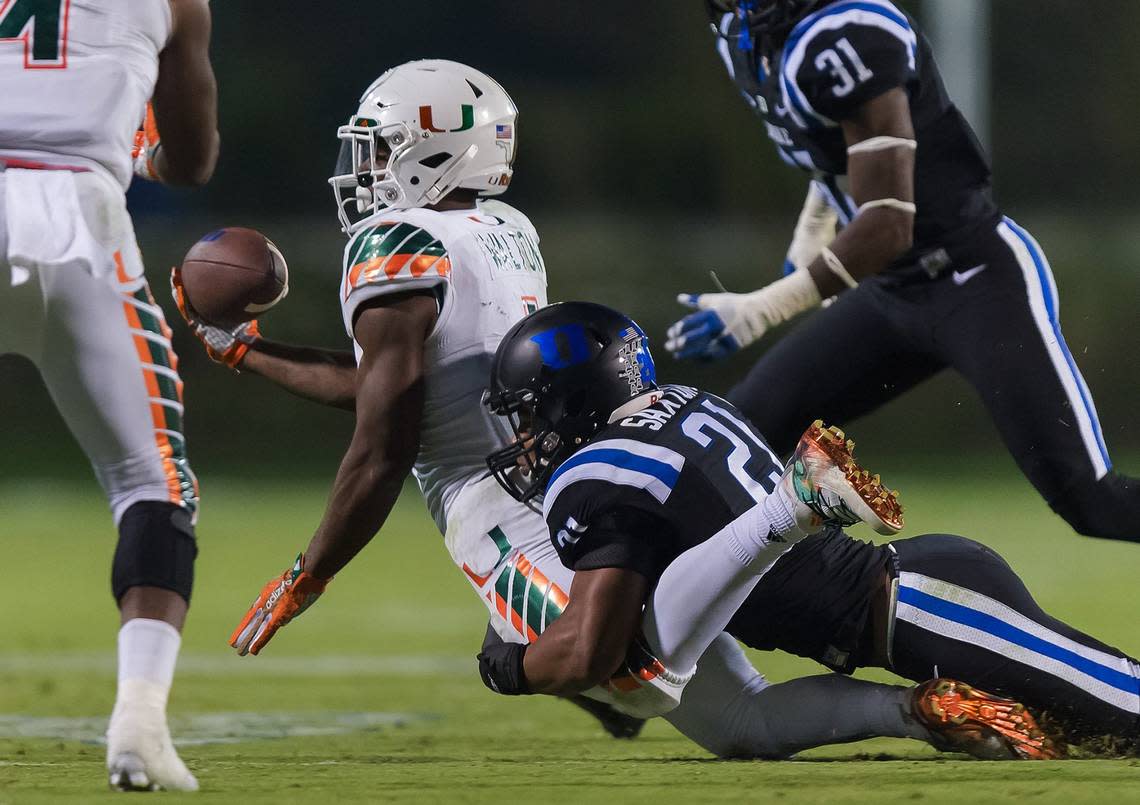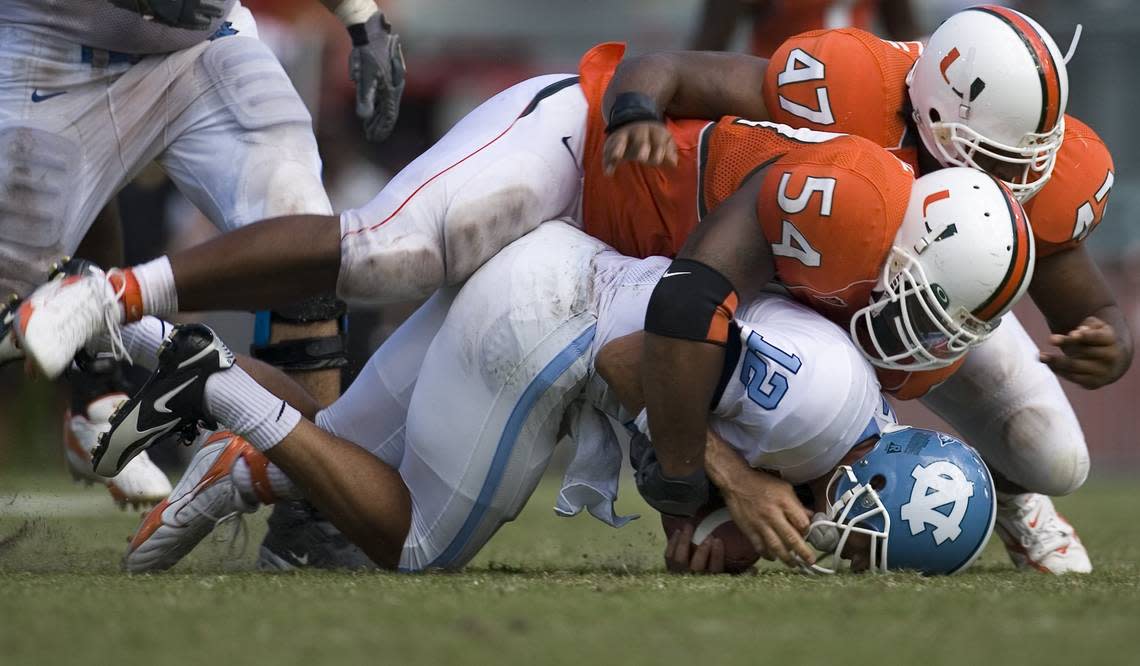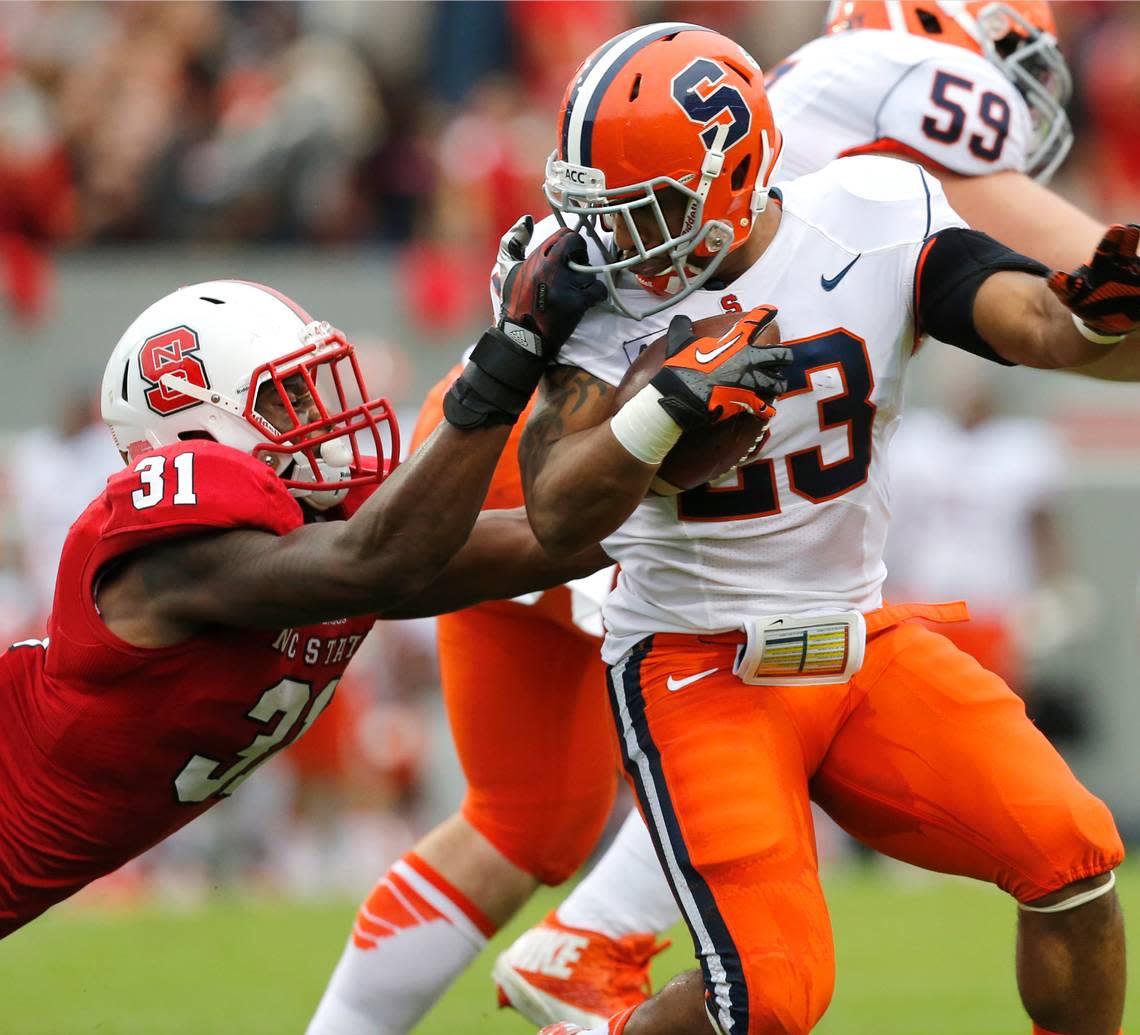ACC helped kick start the conference expansion race which now threatens its survival
On the other end of the phone, Mike Tranghese sighed quietly. It was a sound that conveyed a sense of empathy, if not resignation. The emotions returned, almost 20 years later. Back then, as the commissioner of the original Big East Conference, Tranghese watched with a sense of helplessness while three of his league’s most important schools left for the better financial fortunes of the ACC.
For the old Big East, the spring of 2003 represented the beginning of the end. For the ACC, the spring of 2003 was supposed to represent a new beginning, one that would solidify its status for decades to come. Instead, a new Big East rose from the ashes and has rebuilt itself on its basketball roots. And now the ACC finds itself imperiled by a trend that in many ways it began.
Tranghese, now almost 80 years old and at peace in his retirement from college athletics administration, takes no joy in it.
“I don’t want to see any conference go away, because I’m not certain it’s healthy,” he said. “People have got to have people to play. ... Plus, there’s some people within the walls of the ACC right now who are friends of mine. Who, you know — I don’t want to wish them bad luck.”
Tranghese was speaking last week to The News & Observer, not long after another seismic shift in the industry in which he’d spent a lifetime. Now what did he think of the state of the enterprise and where it all seems to be headed?
“Oh boy,” he said softly, after that sigh. He paused.
Days after the latest conference realignment news, perhaps the most dramatic yet, the ripples were only beginning to reverberate. USC and UCLA, two of the most powerful and successful schools in Pac-12 history, were headed to the Big Ten. In an instant, major college athletics once again entered into a state of instability, if it had ever left it in the first place.
The implications immediately appeared dire for every conference outside of the two wealthiest in the country. About a year ago, Texas and Oklahoma announced their intention to leave the Big 12 for the SEC. Now two of the most recognizable schools on the West Coast planned to abandon their roots next to the Pacific Ocean for northern winters, and a conference based in the Midwest.
The Big Ten and the SEC, which for years had slowly separated themselves from the rest of their Power Five rivals, were no longer only the richest leagues in college athletics. Now they were becoming the largest — “two suns with all the gravitational pull,” as Notre Dame athletic director Jack Swarbrick said in May at the ACC’s spring meetings in Amelia Island, Florida.
From the outside looking in, Tranghese had known what was coming.
“I wasn’t surprised at all,” he said. “I thought the Big Ten was going to do something.”
He’d found it “comical,” he said, that the SEC received criticism for taking Texas and Oklahoma.
“Every one of those other conferences had contacted Texas,” Tranghese said. “I know that for a fact. And Texas and Oklahoma made a decision, they wanted to leave. And they went to the SEC and the SEC got vilified, and so what do people do? They turn around and do the same exact thing.
“That’s the world we live in.”
He could see the end game of that world, if not the clear specifics then the blurry outlines, the details to be filled in. It was a world of consolidation, of “fewer players at the big table,” Tranghese said, and that was when he sighed and sounded a little exasperated about what has become college athletics’ great inevitability — that this all ends with two powerful and rich super conferences, invitation only, and with most schools on the outside, looking in.
“I mean, there are some good programs, when this is all settled, who are going to be left standing alone,” Tranghese said. “That’s scary. Very scary. Having been someone who had to endure this, I feel badly for anybody who this happens to, because it’s the worst feeling in the world.”

Trend begins as Big East is ‘raided’
Few more than Tranghese better understand the reality of college athletics’ new world order — which isn’t much different than its old world order. About 20 years ago, major conferences appeared to have entered into a period of tranquil coexistence, one that turned out to be a mirage.
The ACC, on the strength of a national basketball brand and Florida State’s decade-long dominance in football, paid its nine members a greater share of revenue than any other league. The Big Ten, with 11 schools, and the SEC, with 12, were not far behind.
The Pac-10, as it was then known, was the premier conference out West, and the Big 12 had found its niche in Texas and through the prairies of Kansas and Nebraska. Even the first iteration of the Big East had reason for optimism about its long term health, with Miami’s status as a football power and Virginia Tech’s ascendance to national relevance.
And then the ACC, discontent to remain at nine teams, changed everything. For years, throughout the late 1990s and early 2000s, quiet rumors persisted that the conference was exploring expansion. And for years, commissioner John Swofford and the ACC’s presidents and chancellors demurred and accepted the status quo.
Yet Swofford, sensing that football television revenue would soon drive college athletics’ economic model, encouraged the league to be proactive. With 12 schools, the ACC could hold a football championship game and reap the financial rewards that were sure to come with it. The ACC could also place its flag in lucrative new television markets which, the thought went at the time, would enhance its media rights contract with ESPN.
And so with a 7-2 vote in favor of it, the league’s presidents and chancellors in May of 2003 relented, and agreed to pursue expansion. The two nos came from Duke and North Carolina, with William Friday, the revered former president of the University of North Carolina System, expressing his skepticism and dissatisfaction.
“This decision means it has become a follower of money,” Friday, speaking of the ACC, told the N&O after the conference decided to expand. “What it all adds up to is moving more and more toward becoming America’s entertainment industry.”
Upon his death in 2012, Friday was remembered for his wariness of big-time college athletics and for how he often warned of its potential to corrupt. Yet his displeasure with expansion in 2003 became a footnote in a process that seemed preordained.
Soon enough, a little more than a month after its vote to pursue expansion, the ACC invited Miami and Virginia Tech to join the conference, with both quickly accepting. Months later, in October 2003, Boston College became the third school to announce its decision to leave the Big East for the ACC. While the ACC’s leaders celebrated the moves, and what they believed those additions meant for the conference’s future, Tranghese was left to attempt to hold the Big East together.

He was, at the time, a Big East lifer, the second commissioner in its history. He’d come of age with a deep appreciation of the league’s basketball roots; of those glory years of the 1980s when the likes of Georgetown and St. John’s and Villanova competed for Final Fours and national championships.
Tranghese understood the football side of it, too, and the financial power of that sport. The Big East in 1991 added Miami and others, including West Virginia, who’d been football independents. That happened around the same time Penn State joined the Big Ten, and Florida State the ACC.
Like Miami, Penn State and FSU joined conferences after they’d competed as independents. Until 2003, there wasn’t a precedent of one major conference playing the role of homewrecker in the existence of another. The ACC changed that and, in the process, set off a chain of dominoes that have fallen not in a straight line, but in a large circle that is now leading back to where it all began.
In 2003, Tranghese stayed silent, for a while, as the ACC pursued the schools in the conference he was charged with leading. Then, upon the inevitability of the moves, he released everything that for months had been building. In the spring of 2003, he said the ACC was “ruining programs,” according to a story in the Syracuse Post-Standard, and that ACC expansion would become “the most disastrous blow to intercollegiate athletics in my lifetime.”
“It’s wrong,” he added.
Almost 20 years later, the anger is gone. Enough time has passed.
Tranghese these days does consulting work, and in recent years has worked with the SEC to bolster the conference’s reputation in men’s basketball. He can now speak without emotion about what happened to the original Big East yet he knows, too, that 2003 became a dividing line. There was the version of college athletics before that year, when it seemed like conferences might just be able to live together. And then there’s the world that has come to exist since, with the ACC, Big Ten, Big 12, Pac-12 and SEC operating like contestants on the college athletics equivalent of Survivor, all jockeying to one-up each other, or force their extinction.
“You know, back when the ACC first came and got our teams in 2003, conferences had really never been — I don’t know what the word is,” Tranghese said, before settling on one. “Raided. For a team.
“That was the first time, and there were no consequences. And we were damaged, and the ACC obviously improved its stake. I think people looked around and said, ‘Well, if there’s no negative consequences, why can’t we do it?’ Because I think up until then, people were hesitant to do something like that.
“But, you know, it’s the way of the world now. It’s all about money.”
ACC’s 2003 moves come full circle
While the ACC pursued expansion in 2003, it was the financial envy of its peers. The conference during the 2002-03 fiscal year disbursed an average of almost $11 million to its nine members — about a million dollars more than the Big Ten awarded its schools and about $1.5 million more than the SEC gave to theirs.
At the time, the ACC’s basketball television rights were among the most valuable of any college sports property. Yet Swofford anticipated, correctly, that the economics of major college athletics were about to change. The SEC had been a 12-team league since 1991, allowing it to hold a lucrative football championship game.
The Big 12 came into existence in 1996, with national powers Texas, Nebraska, Texas A&M and Oklahoma all taking turns winning that conference’s first five championship football games. The ACC’s hope, in adding Miami and Virginia Tech, especially, was that its own football championship game would be a windfall, and that it’d solidify the ACC’s position as the nation’s most financially-secure conference.
It didn’t happen that way. For one thing, the anticipated football championship games between Miami and Florida State never materialized. Those schools forged college football’s fiercest rivalry throughout the late 1980s and 90s, and when the ACC adopted a divisional model in football before the 2005 season the league placed the Hurricanes and Seminoles in opposite divisions in the obvious hope that they’d more often than not play for the championship.
Instead, 17 years later, FSU and Miami have never played against each other in the ACC championship game. At the same time the ACC struggled to establish national relevancy in football, college basketball’s stature declined. The result, by the end of the 2000s, was that the conference had lost its position atop college athletics’ established order.
In the seven years that followed its decision to expand in 2003, the ACC’s per-school payout increased from $10.8 million to $11.7 million. In the same span, the Big Ten and SEC, meanwhile, practically doubled their revenue and their payouts to their members. The Big Ten, riding the momentum of the 2007 launch of its own television network, paid its members an average of $20.1 million in 2010. The SEC, in the first year of an historically-wealthy contract with ESPN, disbursed an average of $18.3 million to its schools in the same year.
The ACC, which entered the 2000s in a rush to stay ahead, had fallen behind by the end of the decade. In the years since, the financial gulf with its rivals has only grown more exponential and it will continue to grow, given the Big Ten and SEC will soon benefit from new TV rights deals while the ACC is locked into its own contract with ESPN through 2036. It is all enough for Tranghese to feel a sense of sorrow for the conference that once decimated his own.
“I feel really badly for Jim Phillips,” he said, speaking of the ACC Commissioner, who is in his second year on the job. “I’ve known Jim for a long time ... And you know, I just don’t like seeing anyone put in this position. But it’s the world we live in.”
It’s a world the ACC helped create. After it poached three schools from the Big East, the Big East poached less powerful conferences in an effort to remain solvent. The Big Ten eventually added Nebraska before the ACC went back to the Big East to pick up Syracuse and Pittsburgh and Notre Dame, in everything but football. Then the Big Ten lured Maryland from the ACC and Rutgers from the Big East. Then the ACC added Louisville to replace Maryland.

The Pac-10 became the Pac-12. The Big 12 became a 10-team conference, absorbing losses, before expanding back to 12. The SEC acquired Missouri and Texas A&M, and then last summer came the news of Texas and Oklahoma’s eventual departures for the SEC, leaving the Big 12 with the prospect of shrinking before it, too, added Cincinnati and UCF. And now the Big Ten has plans to become bigger, with the additions of USC and UCLA.
Somewhere in there was “The Alliance,” an agreement among the ACC, Big Ten and Pac-12 that appeared, at its creation, to represent something of a cease fire, at least among those three leagues. It apparently ended when the Big Ten decided it wanted two of the Pac-12’s most valuable properties, and the interest apparently was mutual.
Which brings us to the present, and a moment in which everyone outside of the SEC and Big Ten find themselves anxious and concerned about what might happen next. Some schools, undoubtedly, would be in demand should those two leagues decide to grow even larger. Others, as Tranghese put it, would be “left standing alone.” And what of the conferences themselves? Tranghese has been there, left to attempt to hold one together in the face of insurmountable odds and forces.
“I mean, I got vilified,” he said, speaking to the demise of the original Big East, “because I didn’t do this, I didn’t do that, I didn’t do this. The problem was was we weren’t strong enough in football. And when Miami and Boston College, and eventually Virginia Tech had a chance to enhance their position, they did. And it’s like you can’t criticize the person in charge. If they don’t have the ammunition to withstand people coming, you’re susceptible. And there’s people that are susceptible.”
Twenty years ago, the ACC sought to fend off any potential long term susceptibility. It went on the attack, and in a way unlike any other major conference had ever done. Now it finds itself on the other side, bound by a grant of media rights that’s holding the conference together, for now, while the Power Five has become the Power Two.
